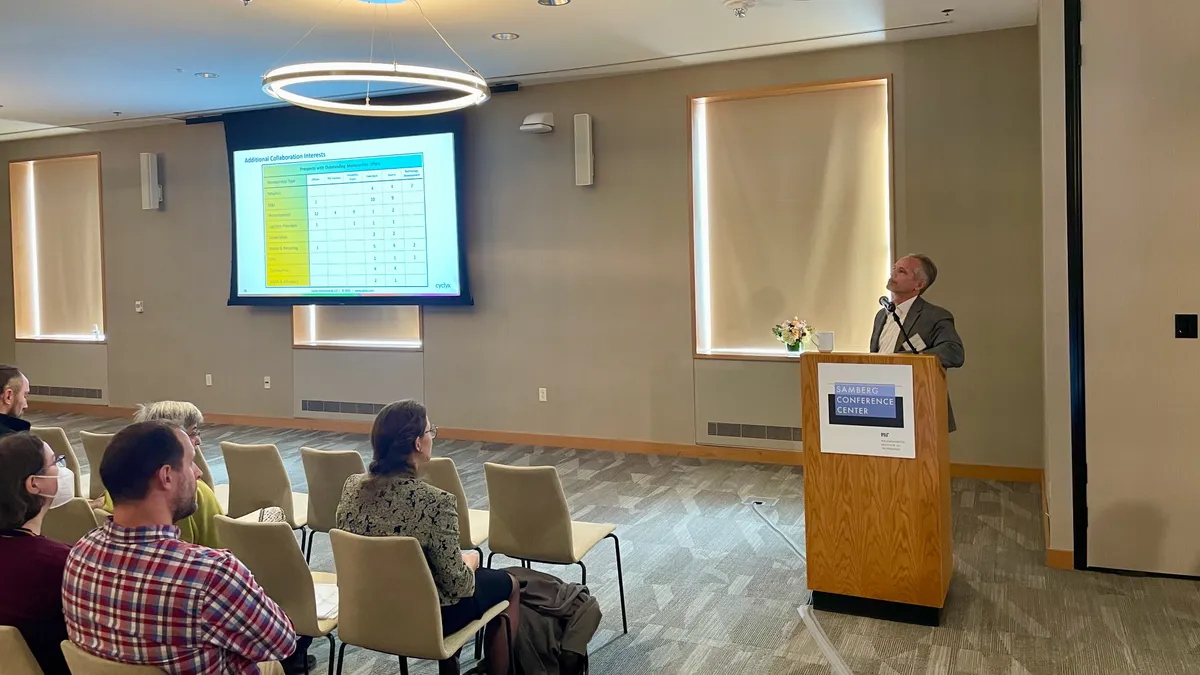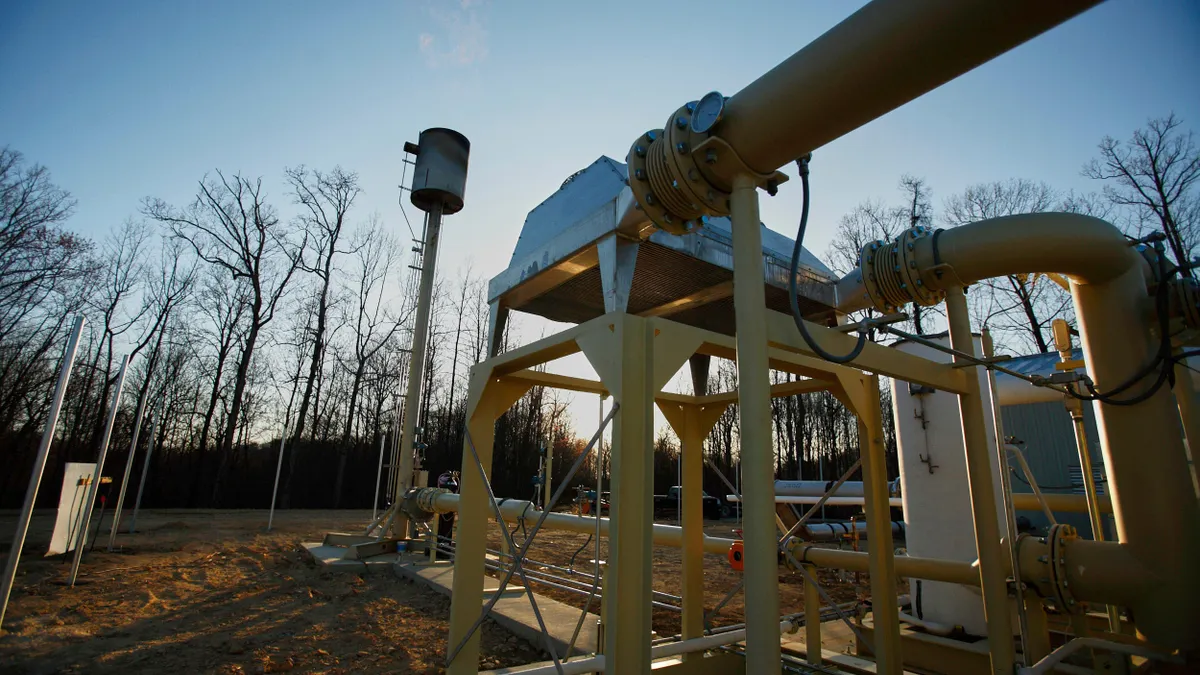The chemical recycling sector may still be in its nascent stages, but proponents believe that’s about to change and see a clear role for existing waste and recycling companies that run systems today.
On Monday, at a Single-Use Plastic Circularity Summit hosted at the Massachusetts Institute of Technology in Cambridge, speakers gathered to focus on recycling material from healthcare and life science sectors. Their discussions also had broader implications about a category of technologies, known as chemical or advanced recycling, that can process plastic into chemical compounds or fuel products.
Joe Vaillancourt, CEO of Cyclyx, said the reason recycling rates are low for plastic (around 10%) is because collection and processing infrastructure isn’t designed to handle the full spectrum of products on the market. He described the current moment as a chicken or egg situation, in which recyclers and petrochemical companies are both waiting to fully scale up their infrastructure until the chemical recycling concept is ready.
"Why [are] any of the waste companies going to change their systems, how they handle and manage material and create new material that could go to a new market, if that market is not built yet?" he asked.
Vaillancourt previously spent 15 years at WM, where he was a founding member of the company’s corporate venturing group that explored a variety of processing technologies. He said major waste companies likely won’t invest further until petrochemical companies get more engaged, but those companies may not invest until they can economically access reliable quantities of feedstock.
He described Cyclyx, a consortium founded in 2020 as a subsidiary of Agilyx, as a new approach to help align these interests. Cyclyx currently has 30 members, including Casella Waste Systems and many plastics-related companies, with more expected to join soon.
Vaillancourt outlined plans to address these feedstock constraints with new “circularity centers” being designed that could handle “all plastics” for processing in a more responsive way than single-stream MRFs, which sort material by item type versus chemical makeups. This technology could potentially be licensed or run by Cyclyx itself.
Capturing more feedstock from healthcare and life science customers was a particular focus at the event, as these settings generate large volumes of single-use plastic waste that often isn’t accepted in standard recycling systems.
The Healthcare Plastics Recycling Council, a group formed in 2010, has been working to collect sample loads for chemical recyclers with the goal of potentially launching a large program to prove out the concept. Based on initial feedback, Executive Director Peylina Chu said “healthcare plastics does look like a very valuable feedstock to them.”
Regional companies Triumvirate Environmental and Casella Waste discussed their own efforts to capture more plastics from these settings, along with other industrial locations, through a variety of targeted collection programs. They described sorting requirements and limited space for additional bins as a challenge in some cases, but one that can be addressed.
"The biggest challenge is on accessing that feed and getting that waste in a way that is economic. So I think that's where we're going to have to see the biggest changes,” said Natalie Martinez, feed to value business manager for ExxonMobil Chemical.
ExxonMobil, a founding member of Cyclyx, is working to scale up a variety of pilots and takeback programs for multiple waste streams. One example, outside of the scientific space, is a partnership with LyondellBasell, the city of Houston and FCC Environmental Services to collect certain plastics from schools, homeowner associations and retailers. Another partnership with Sealed Air and Ahold Delhaize is focusing on using flexible plastics “from the food value chain” to make food-grade packaging.
Martinez said Exxon wants to partner with more MRF operators on accessing certain flexible plastic films — such as chip bags or candy wrappers — that are currently classified as contaminants. "You don't want them, but you get them anyway. Can we still figure out how to deal with them?” In her view, these products would ideally be invited into the curbside stream.
While some recyclers have explored this concept over the years, the limited quantity, operational complications and low value of this material have limited interest. A representative for Casella didn’t weigh in on this particular aspect, but described the company as an interested party.
"Mechanical processing is working for us today,” but it’s not the only solution for the future, said Elaine Wagener, a national account manager in Casella’s Resource Solutions division. With this in mind, Wagener said Casella sees itself as a partner to help bridge the gap between the two.
Wagener cited one example of how postconsumer resin can make products look cloudy, which may not be popular with consumers, but said chemical recycling could help solve for this. Martinez also said ExxonMobil viewed chemical recycling feedstock as potentially easier to incorporate into new products.
Jeremy Wallach, a senior partner at McKinsey & Co., described this current moment as one where packaging companies and manufacturers are starting to seriously engage on recycled content beyond just making pledges. Based on the consulting firm’s discussions with many of these companies (including for a recent report that stated plastics are preferable from a lifecycle standpoint in many cases) he said it’s possible that recycled content levels could double in the years ahead.
"It could get really big,” he said. "You could see a path to 15 or 20% recycled content by the end of the decade."
Like others, Wallach noted a similar limitation to the potential role of chemical recycling in this process.
"The wave of investment we think has sort of gotten to the point where actually the constraint is now the feedstock. It's getting the quantity of feedstock so that you can feed the machine and keep this thing running."
Only a handful of chemical recycling facilities are currently operating in the U.S., though dozens more are pending. Many are at a small scale, which Vaillancourt said makes them easy targets for critics that question the idea’s financial viability. He said such critics are “going to try to not allow the transition to happen to begin with” and believes more legislative support is needed.
While the American Chemistry Council has successfully lobbied for many supportive state laws in recent years, the technology’s role has largely not been solidified in more consequential extended producer responsibility laws or related packaging policies. Vaillancourt believes the key to gaining legislators’ support is proving out the technology and if that can happen “how they think about what is recyclable will change.”
At a time when individual plastic recycling projects are becoming focal points for environmental justice concerns, major philanthropic money is flowing into opposing new petrochemical plants and the role of plastic in packaging is being questioned, this will be a complicated effort at the state and federal level. Opponents of chemical recycling say it’s a way for petrochemical companies to justify growing levels of plastic production, rather than a needed form of waste management, and would prefer to see more reduction or reuse efforts instead.
Vaillancourt described his broader vision as a multi-decade timeline, but if successful he believes it could reframe current investments in virgin plastic production and shift the economic model around material that has already been disposed. In the future, he said, chemical recycling could be viewed as an “above ground oil well” and there could be an opportunity for a “future fracking where you could actually mine landfills cost competitively to get those plastics out.”
First, proponents will need to prove these technologies can be scalable and politically palatable before unlocking the reliable quantities of feedstock they believe is necessary to make this future happen.
"Once these things start to go, that's when the infrastructure's going to happen,” said Vaillancourt, describing that as the moment when waste companies and MRF operators may get more engaged. “I think they're slow adopters. They need to be, because they have legacy assets that they're trying to optimize. But they're really the ones who can muscle this to actually create the scale that everybody wants to see.”


















